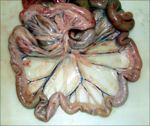Jejunum - Anatomy & Physiology
Jump to navigation
Jump to search
BACK TO ALIMENTARY - ANATOMY & PHYSIOLOGY
BACK TO SMALL INTESTINE - ANATOMY AND PHYSIOLOGY
Structure
- The jejunum is the longest part of the small intestine.
- It is highly coiled and occupies the ventral part of the abdominal cavity, filling those parts that are not occupied by other viscera. This produces species variation (see comparative aspects).
- It is suspended by the mesentry (mesojejunum). This conveys the blood vessels and nerves and houses lymph nodes.
- The mesentry converges to its root. This is where the cranial mesenteric artery branches off from the aorta.
Function
- Has digestive and absorptive functions.
Vasculature
- The cranial mesenteric artery, a branch of the abdominal aorta, supplies blood to the jejunum, ileum, caecum, ascending colon and part of the transverse colon.
- It branches greatly within the mesenty of the jejunum.
- There are many anastomoses within the mesentry, which ensure that the intestine can survive even if a major division of the cranial mesenteric is damaged.
- The cranial mesenteric vein drains blood from the jejunum and enters the portal vein.
- It is rich in the products of digestion following a meal.
- The portal vein enters the liver.
Species Differences
- The position of the jejunum is variable between species as it lies in that part of the abdomen not occupied by other viscera.
- In the dog, it lies roughly symmetrically about the midline. It contacts the liver, stomach and spleen cranially and urinary bladder ventrally. It lies on the deep sheet of the greater omentum.
- In the ox, it is pushed entirely to the right side of the abdomen by the rumen which is on the left. Coils of the jejunum usually lie within the supraomental recess; although this can vary between individuals depending on fullness of the rumen and size of the uterus.
- In the horse, the coils of jejunum ane confined to the left dorsal part of the abdomen. It is restricted to this position by the large caecum on the right, and ascending colon ventrally on both sides.
